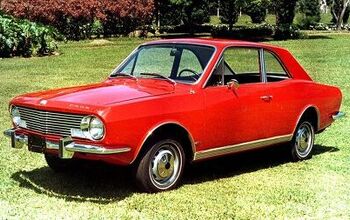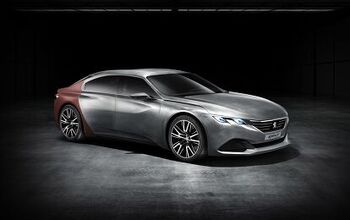Dispatches Do Brasil: Movin On Up!

As of late Brazil has been on a roll and a multitude of makers have set up or are in the process of setting up in our tropical paradise. Everybody from Jaguar to Hyundai (not to mention a motley crew of Chinese brands) are placing their bets, but they face an obstacle that nobody has really noticed: the existence of a number of foreign makes that locals consider, well, local. Among them, the most Brazilian of makes – Volkswagen. Currently trailing Fiat, and sometimes GM, VW nonetheless is as Brazilian as feijoada, and for the first time in decades, VW has deemed us worthy of getting a taste of the best they have to offer on their European menu, the whimsically named up!.
The Brazilian up! at 142 inches long is 2.5 inches longer than the European one. Although it is about an inch taller than the Euro version, its width and wheelbase remain the same. The extra length is explained by the need for more trunk (285m³) and the extra height is due to a taller stance that better handles our bad roads, and VW recognizing that some extra tirewall does add comfort. In Europe the up! is strictly a four seater, while here it is homologated for five. Other differences include rear windows that actually go down and a hatch made of metal and not glass.
Though it starts at a reasonable R$26,500 (and goes up to a very unreasonable R$46,000), most versions are equipped with the bare, legal minimum level of safety features(ABS and 2 frontal airbags – thank God for government regulation) and all desirable equipment (electrical windows, locks, AC and on it goes and goes and goes) costs a pretty penny. Besides the looks, the mini VW pales in comparison to some of the competition in terms of features, but VW does have a trump card.
Surprisingly enough, that ace comes in the form of a 3 cylinder 1.0L 12v engine. Believe me, it’s a gem. It has an aluminum block, variable valve timing and a double cooling circuit (which allow the head and block to work at different temperatures). All of this, I’m told, helps the little engine in terms of efficiency and output. The mill corrals 75 horses on Brazilian gas (E25) and 82 hp on pure Brazilian ethanol.
More importantly, 85% of total torque (9.7m.kgf and 10.4m.kgf, respectively) is available at a low 2000 rpm. While the engine struggles a little against its inherent 3 cylinder imbalance at idle, the effect is minimal in comparison to other brands (namely Hyundai’s) 3 cylinders in our market. Most Brazilians will not even notice it’s not an I4. It also pulls very well up to its lofty redline and thanks to its suave functioning, it never feels unduly strained.
Top speed is a little low, around 165km/h, and 0-100km/h is accomplished at about 12-13 seconds. The consumption is the highlight of this car. Real world drivers are reporting 10km/l in heavy stop and go traffic. Other cars in the 1.0L category, in such circumstances, rarely get more than 9.
I find most Volkswagens a tad on the stiff side, especially the best-selling VW in Brazil and perennial market leader, the Gol. The Gol is fun to take out on the road and gun it, a situation in which it shines. However, in the city, that extra stiffness proves not at all pliant. That makes for a downright unpleasant ride. The up! on the other hand, took the curves I threw at it in a nonchalant manner, all the while being quite comfy in our slow traffic and took in the bumps on our imperfect pavement in a more civilized fashion. I hope this sets a trend for future VWs. Though surely stiffer than some of the competition, the up!’s suspension system does not add discomfort at low speeds due to its relative competence at higher speeds.
Once inside the car, most Brazilian buyers will probably be pleasantly surprised. In spite of the gimmicky flat bottomed steering wheel, the rest of the interior is modern and minimalist. VW was careful in choosing plastics that did not feel any less substantial than that in competitors. Some will balk at the metal apparent on the doors, a throwback to more pristine times, but on the whole it seems rather well screwed together with no glaring deficiencies as to finishing. Instrumentation is adequate, as are seat adjustments. The seating position is very pleasant and one does sit more up than in other small VWs, which I wholeheartedly endorse. Seats, pedals and wheel are almost perfectly aligned and the gear shift action is minimal and light, and most especially quiet. I, who stands 1.8m tall, found headroom and shoulder room more than adequate while in the back footroom and hiproom are at a premium.
The most glaring defect is that air vents are only present off to the side. In the center console there’s simply no room. Up on the dashboard, close to the windshield, there is another one, but its adjustability is limited. Also, since the infotainment system is a couple-on affair that goes right in front of that vent, its usability is rendered even lower. On the day I drove the car it wasn’t that hot, so I didn’t suffer, but I’d be wary of the apparent lack of climate control in a country where temperatures can get up to and above the 40°C mark in the summer.
Due to its tall greenhouse, sight lines are better than in most, though the pillars can intrude. In all honesty I expected better, but quite good for a modern car. The light steering and compact dimensions, added to the adequate sight lines make city parking quite easy. Finally, this is the second Brazilian car to score a perfect five star rating in Latin NCap testing. So, safe it is.
All in all, a nice surprise from VW. The Volkswagen up! offers great economy, tidy but relatively spacious cabin, modern internal ambience, technological gadgets, safe, nice interior design, great exterior design. If you can stomach the relatively high asking price, and the usual VW-games with accessories, this is a Volkswagen that even I would be happy to own.

More by Marcelo de Vasconcellos
Latest Car Reviews
Read moreLatest Product Reviews
Read moreRecent Comments
- 3-On-The-Tree 2014 Ford F150 Ecoboost 3.5L. By 80,000mi I had to have the rear main oil seal replaced twice. Driver side turbo leaking had to have all hoses replaced. Passenger side turbo had to be completely replaced. Engine timing chain front cover leak had to be replaced. Transmission front pump leak had to be removed and replaced. Ford renewed my faith in Extended warranty’s because luckily I had one and used it to the fullest. Sold that truck on caravan and got me a 2021 Tundra Crewmax 4x4. Not a fan of turbos and I will never own a Ford again much less cars with turbos to include newer Toyotas. And I’m a Toyota guy.
- Duke Woolworth Weight 4800# as I recall.
- Kwik_Shift_Pro4X '19 Nissan Frontier @78000 miles has been oil changes ( eng/ diffs/ tranny/ transfer). Still on original brakes and second set of tires.
- ChristianWimmer I have a 2018 Mercedes A250 with almost 80,000 km on the clock and a vintage ‘89 Mercedes 500SL R129 with almost 300,000 km.The A250 has had zero issues but the yearly servicing costs are typically expensive from this brand - as expected. Basic yearly service costs around 400 Euros whereas a more comprehensive servicing with new brake pads, spark plugs plus TÜV etc. is in the 1000+ Euro region.The 500SL servicing costs were expensive when it was serviced at a Benz dealer, but they won’t touch this classic anymore. I have it serviced by a mechanic from another Benz dealership who also owns an R129 300SL-24 and he’ll do basic maintenance on it for a mere 150 Euros. I only drive the 500SL about 2000 km a year so running costs are low although the fuel costs are insane here. The 500SL has had two previous owners with full service history. It’s been a reliable car according to the records. The roof folding mechanism needs so adjusting and oiling from time to time but that’s normal.
- Theflyersfan I wonder how many people recalled these after watching EuroCrash. There's someone one street over that has a similar yellow one of these, and you can tell he loves that car. It was just a tough sell - too expensive, way too heavy, zero passenger space, limited cargo bed, but for a chunk of the population, looked awesome. This was always meant to be a one and done car. Hopefully some are still running 20 years from now so we have a "remember when?" moment with them.


































Comments
Join the conversation
Great test Marcelo! Is the reliability of this new VW UP! or DOWN¿
The up! is one VW I'd consider owning. I saw a very compelling video review of this vehicle a while ago, and it's a pretty nice car.